On our way to the Heydar Aliyev Cultural Center, we came across these men playing chess and backgammon in a small park.
To give you a sense of the scale!
Peter Cook in Architectural Review called Hadid's masterpiece "a white vision, outrageously total, arrogantly complete ... a unique object that confounds and contradicts the reasonable ... a wave form sweeping up, almost lunging, into the sky ... here is architecture as the ultimate statement of theatre ... It is the most complete realization yet of the Iraqi-born architect's vision of sweeping curves and flowing space."
Never have we wanted to explore so thoroughly the exterior of a building before entering it. The building was so mesmerizing, it changed and evolved as we continued our journey around it, viewing it from different angles!
The Center, completed in 2013, was a gigantic cultural and conference center and contained three auditoriums, a library and museum, with a total space of 10,801 square meters. It was named after the former president and father of the current president of Azerbaijan.
In the end Steven decided to not enter the Cultural Center, preferring to enjoy the sunny weather outside. As I had never climbed a staircase like this one before, I wanted to make sure not to be too close to the inside edge and hit my noggin on the wall or was it the ceiling! The stairs appeared to melt effortlessly into the lines of the ceiling.
The almost total absence of color was jarring as the lack of variation and depth perception made me feel out of whack and off kilter. I was fascinated and intrigued but felt somewhat I had entered a House of Mirrors!
Much later I watched with great amusement, and often with admiration, as several people attempted to imitate this same pose with varying degrees of success!
An exhibit on Regional Costumes pointed out that a series of fabric pieces found during archaeological excavations demonstrated that there was a 'high dressing culture' in what is now Azerbaijan well before Christ was born. Since then, garments created throughout Azerbaijan have "distinguished themselves with the quality of fabrics, delicacy of pattern and unique nature of decoration ornaments."
A mini version of the futuristic-looking airport:
This was of Maidens Tower that we saw our first afternoon while walking in the Old City.
Steven and I had also seen the International Mugham Center a couple of days previously just beside the Carpet Museum.
This was a model of the State Philharmonic Hall that we had walked passed but didn't mention in an earlier post.
If you read the previous posts on Baku, I am sure you won't have any problem recognizing one of Baku's most iconic sights, the Flame Towers!
My hat's off to you if you also recognize the one of a kind Carpet Museum that we thought was so special!
I loved how someone wrote that "Hadid's brilliant design tricked the eye by weaving the floor and the walls of the building as if everything was one huge wave."
It had been a long, long time time since I had seen a show on dolls so I was curious to see the Art Doll exhibit. I read that, according to historic sources, the earliest dolls were crafted over thirty to forty thousand years ago and were used as toys, souvenirs or mascots depending on the time period. Gradually, doll making developed into a separate art of its own. It seemed a little fanciful to me to read that each of the dolls in the exhibit told a specific story and featured its own aura, emotions and a peculiar mystical world. I learned that rare dolls are cherished in private collections, museums and galleries.
This lovable Pinocchio was created in the 19th century in Italy.
I think this metal and plastic version of Eve made by a Belgian in 2009 blurred the lines when it was included in a doll exhibit as it was hardly soft and cuddly. What do you think?
I discovered that Portrait Dolls are the images of familiar people known to everyone. The artists made portrait dolls after being impressed by historical figures and well-known people in the arts to keep them 'alive' in our hearts.
I was absolutely taken with the hat displays - they looked so cute, I wanted to eat them!
I felt dizzy looking at this Parabolic Twist created in 2013!
Remember my stating in an earlier post about not having realized previously that Azerbaijan was famous for its carpet-making skills? I realized I wasn't alone when I read the following snippet at the museum. The italics are mine. "Azerbaijan has always been the school of the Caucasian carpet making for 90% of carpet designs 'Caucasian' is made of Azerbaijani design. It is unforgivable that indigenous Azerbaijani carpets are kept at the world's best museums under the title of Persian or Armenian carpets."
The fish reminded people of the wealth from the nearby Caspian Sea.
It's impossible to spend any time in Azerbaijan without knowing of the intrinsic link the country has had with oil for more than two hundred years. This sludge pump to extract oil was used at the beginning of the 20th century.
There were the requisite ancient tools, rocks and other items befitting a National History Museum but they were of less interest than the oil baron's art nouveau bedroom! Building materials, furniture, chandeliers and other items for the interior were brought from Russia and Western Europe for the home or palace as it was described.
The ceiling in the baron's wife's boudoir was made of mirror plates which looked like stalactites on the perimeter which was typical for Azerbaijani architecture!
When we entered the beautiful Oriental Hall, the home did indeed look like a palace. I could just imagine the balls that must have taken place there.
We returned to the Old City to see the small Museum of Miniature Books as it was closed the other day.
It brought back great memories when we saw some of the Little Golden books we had read to our four children so long ago. I wonder if any of them remember the stories as I still do?
The tiniest books were no more than a half inch in size!
We left by the attractive Old City Gate.
Side by side: the old and new Baku as represented by the city walls and the glass pyramid of the central metro station that we had come to know so well even in our short time in the capital of Azerbaijan.
We only spent a few days in Azerbaijan, far less than any other country on this year's trip, so not enough to get a good sense of the nation and its people. However, I was charmed by much of Baku: its historic Old City, its breathtakingly beautiful modern architecture, its many parks and fountains and was also intrigued by its ancient petroglyphs and its oil history that has helped to define present-day Azerbaijan.
Next post: A few hours exploring Almaty, Kazakhstan.
Posted on September 19th, 2018, from Bishkek, Kyrgyzstan.
Having read about the remarkable Heydar Aliyev center when planning our itinerary, Steven and I were almost dumbstruck when we came across the spectacular building designed by the Iraqi-British architect Zaha Hadid.
We have never seen a building that was so jaw-dropping original, so fluid so that the ground simply rose up to become the building's walls with no demarcation between the two!To give you a sense of the scale!
Never have we wanted to explore so thoroughly the exterior of a building before entering it. The building was so mesmerizing, it changed and evolved as we continued our journey around it, viewing it from different angles!
The Center, completed in 2013, was a gigantic cultural and conference center and contained three auditoriums, a library and museum, with a total space of 10,801 square meters. It was named after the former president and father of the current president of Azerbaijan.
In the end Steven decided to not enter the Cultural Center, preferring to enjoy the sunny weather outside. As I had never climbed a staircase like this one before, I wanted to make sure not to be too close to the inside edge and hit my noggin on the wall or was it the ceiling! The stairs appeared to melt effortlessly into the lines of the ceiling.
The almost total absence of color was jarring as the lack of variation and depth perception made me feel out of whack and off kilter. I was fascinated and intrigued but felt somewhat I had entered a House of Mirrors!
Much later I watched with great amusement, and often with admiration, as several people attempted to imitate this same pose with varying degrees of success!
An exhibit on Regional Costumes pointed out that a series of fabric pieces found during archaeological excavations demonstrated that there was a 'high dressing culture' in what is now Azerbaijan well before Christ was born. Since then, garments created throughout Azerbaijan have "distinguished themselves with the quality of fabrics, delicacy of pattern and unique nature of decoration ornaments."
Mini-Azerbaijan showcased miniature models of the many beautiful buildings around Baku.
A mini version of the futuristic-looking airport:
This was of Maidens Tower that we saw our first afternoon while walking in the Old City.
Steven and I had also seen the International Mugham Center a couple of days previously just beside the Carpet Museum.
This was a model of the State Philharmonic Hall that we had walked passed but didn't mention in an earlier post.
If you read the previous posts on Baku, I am sure you won't have any problem recognizing one of Baku's most iconic sights, the Flame Towers!
My hat's off to you if you also recognize the one of a kind Carpet Museum that we thought was so special!
I loved how someone wrote that "Hadid's brilliant design tricked the eye by weaving the floor and the walls of the building as if everything was one huge wave."
It had been a long, long time time since I had seen a show on dolls so I was curious to see the Art Doll exhibit. I read that, according to historic sources, the earliest dolls were crafted over thirty to forty thousand years ago and were used as toys, souvenirs or mascots depending on the time period. Gradually, doll making developed into a separate art of its own. It seemed a little fanciful to me to read that each of the dolls in the exhibit told a specific story and featured its own aura, emotions and a peculiar mystical world. I learned that rare dolls are cherished in private collections, museums and galleries.
This lovable Pinocchio was created in the 19th century in Italy.
Another version of course!
Normally I think of dolls providing comfort, solace and joy. I don't think those characteristics could apply to this Russian-made doll called I'm a Stranger Among People created in 2012!I think this metal and plastic version of Eve made by a Belgian in 2009 blurred the lines when it was included in a doll exhibit as it was hardly soft and cuddly. What do you think?
I discovered that Portrait Dolls are the images of familiar people known to everyone. The artists made portrait dolls after being impressed by historical figures and well-known people in the arts to keep them 'alive' in our hearts.
The star-crossed lovers, Romeo and Juliet, were created in 2002 in Russia.
An Azeri woman created the Mad Hatter in 2012. What a work of art it.
I really liked the collection of Wooden Dolls as they depicted different facets of Azerbaijan's culture.
The Fashion Habitat exhibit described how fashion designers have for centuries gained inspiration from their imagination and from looking at their surrounding world. This show demonstrated the link between fashion and nature in the form of flowers, berries, fruits and birds from the 18th to the 21st centuries!
Jorge Marin created his 583 kg Rotated Angel in 2013.
I have seen innumerable items that have grabbed my attention in museums and galleries in our travels these last six years but this sculpture was unique. As it was stark white like almost the entire museum, it didn't pop out and scream for attention as it might have if it were colored.
Almost stuck away on its own without anything nearby, I could't stop looking at it wondering what held it up as it looked like it would collapse if someone ran by! There was no sign that said Don't Touch but I have been in enough museums to know I shouldn't give in to my impulse to reach out and do exactly that! The almost lacy confection by Jaume Plensa was titled Self Portrait.I felt dizzy looking at this Parabolic Twist created in 2013!
I could readily see why this swooping architectural masterpiece has become a landmark of modern Baku. It made me want to search out other works by the remarkably talented Zaha Hadid around the world.
After telling Steven what a phenomenal experience he had missed visiting the Cultural Center, we walked to the bottom of the ramp to look at some works by the Iranian-Azeri photographer Reza whose pieces have graced the cover of National Geographic Magazine 25 times. Wikipedia states "His photographs are testimony to the chaos of war, its ravages and the helplessness of human beings caught in the storm. They also tell the world's cultures, traditions, history and, most of all, Reza's infallible hope for a better world." When you have a few moments, I urge you to Google Reza's works so you can see his amazingly powerful photos and read his comments associated with some of his photos - you won't regret it!
Jumping back on the metro, we went downtown to stop in at the Historical Museum located in the mansion of one of Baku's greatest 19th century oil barons.
The entrance hall was lovely but the exhibits on the main floor were very ho hum in my opinion. I think I was hoping for more after the splendor of the Aliyev Center.
Who couldn't smile when seeing this iron and glass stallion?!Remember my stating in an earlier post about not having realized previously that Azerbaijan was famous for its carpet-making skills? I realized I wasn't alone when I read the following snippet at the museum. The italics are mine. "Azerbaijan has always been the school of the Caucasian carpet making for 90% of carpet designs 'Caucasian' is made of Azerbaijani design. It is unforgivable that indigenous Azerbaijani carpets are kept at the world's best museums under the title of Persian or Armenian carpets."
The fish reminded people of the wealth from the nearby Caspian Sea.
It's impossible to spend any time in Azerbaijan without knowing of the intrinsic link the country has had with oil for more than two hundred years. This sludge pump to extract oil was used at the beginning of the 20th century.
Both Steven and I were surprised about the references to Jewish settlements and synagogues in Azerbaijan. At the end of the 19th century, there were 11 synagogues built in the Jewish settlement of Krasnaya Sloboda, Christine. Knowing how Jews were often treated, I wondered whether the information stating that the Jews were "welcomed by the Azerbaijanis and performed their rites unimpeded" was really the case or a whitewash of the facts.
This piece was called Revolution.There were the requisite ancient tools, rocks and other items befitting a National History Museum but they were of less interest than the oil baron's art nouveau bedroom! Building materials, furniture, chandeliers and other items for the interior were brought from Russia and Western Europe for the home or palace as it was described.
The ceiling in the baron's wife's boudoir was made of mirror plates which looked like stalactites on the perimeter which was typical for Azerbaijani architecture!
We returned to the Old City to see the small Museum of Miniature Books as it was closed the other day.
It brought back great memories when we saw some of the Little Golden books we had read to our four children so long ago. I wonder if any of them remember the stories as I still do?
We left by the attractive Old City Gate.
Side by side: the old and new Baku as represented by the city walls and the glass pyramid of the central metro station that we had come to know so well even in our short time in the capital of Azerbaijan.
What a cute shot of my love, still smiling after traipsing through so much of Baku so we could see the last places we wanted to visit before moving on the next morning!
Next post: A few hours exploring Almaty, Kazakhstan.
Posted on September 19th, 2018, from Bishkek, Kyrgyzstan.




















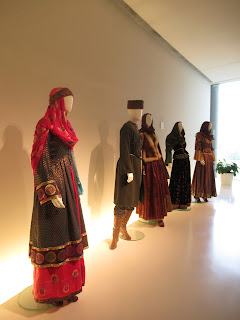








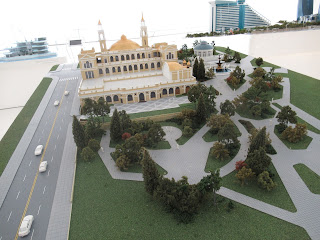



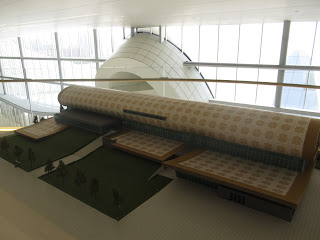

























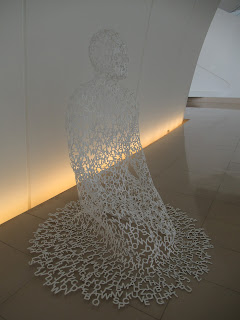

















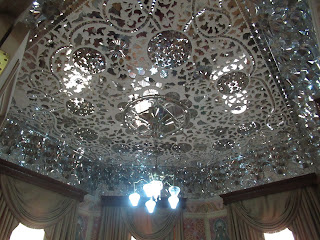




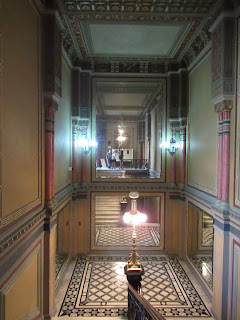










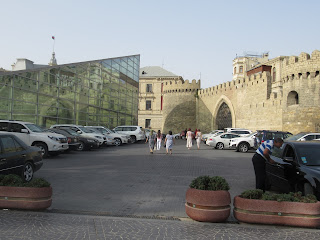


I was wondering, on that unique sculpture that seemed so delicate what was the significance of the alphabet? Like so many words, what was it trying to say?
ReplyDeleteInteresting name for the Jewish settlement. Sloboda means freedom. I wonder what Krasnaya means.
ReplyDeleteChristine, I thought you and Mike might like that reference to the Jewish settlement. Had Mike known about it, I wonder? I just googled 'Krasnaya' and found out it meant 'beautiful' in old Russian and has only come to mean 'red' in more modern times. Thanks for reading the post! Annie
Delete